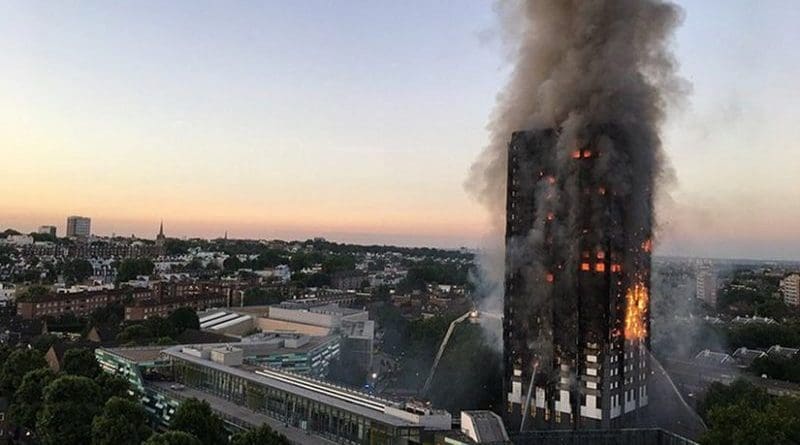Four Years After Grenfell Tower Fire: It’s All About Profit And No Accountability – OpEd
Four years ago, when Grenfell Tower, a 24-storey tower block in west London was engulfed in an inferno, leading to the deaths of 72 people, it became apparent that everyone with responsibility for the safety of the block’s residents had failed to fulfil their obligations.
Those with blood on their hands included the Tory government, obsessed with cutting “red tape”, and failing to implement the lessons learned from previous tower block fires, and the local council, Kensington and Chelsea, which, in common with councils across the capital and the country as a whole, have largely neglected the maintenance of their social housing, content to subject it to “managed decline”, despite receiving millions of pounds in rent, in a manner that resembles nothing less than the behaviour of slum landlords.
The process of “managed decline” eventually enables councils to claim that estates need to be demolished, even though they are responsible for their dilapidation in the first place, at which point developers magically appear with proposals to ”regenerate” the estates with a mix of private properties for sale (generally at least half of the new housing), along with other forms of housing described as “social housing” or “affordable housing”, even though, in reality, they tend to be dubious “shared ownership” deals, or rented properties that are much more expensive than those that have been demolished.
At Grenfell, another layer of uncaring bureaucracy came into play when Kensington and Chelsea Council transferred all its social housing — 10,000 properties in total — to the Kensington and Chelsea Tenant Management Organisation (KCTMO), an ALMO (arms length management organisation) that seems to have been free of even the limited accountability and scrutiny under which councils operate.
It was under the KCTMO that the final component of the disaster of June 14, 2017 came into play — the re-cladding of the tower in 2015-16, in which, alarmingly, flammable cladding, especially involving ACM (aluminium composite material), and flammable insulation materials were both used. How they came to be used is a sordid saga that has been revealed, in agonising detail, in the official Grenfell Tower Inquiry — one that involves some flammable materials being legal when they clearly shouldn’t have been, evidence of companies hiding the flammability of their products, and a safety inspection system that was completely unfit for purpose.
Four years on, the Grenfell Tower fire continues to expose how those living in high-rise council flats were — and in many cases continue to be — regarded as second-class citizens by those with responsibility for their safety, to the extent that, in search of cost-cutting and profiteering, their very lives can be regarded as worthless.
That harsh but fundamental truth should never be forgotten, but in the four years since Grenfell what has also become apparent is not just how those living in inadequately maintained local authority tower blocks are regarded as disposable second-class citizens, but how this fundamental disregard for human life also encompasses those in private developments— or in the mix of private and housing association developments that replace existing council estates after decades of “managed decline”, as noted above.
The scale of the problem is enormous, and underpinning it all is, yet again, the notion, amongst politicians and developers, that profits shouldn’t involve accountability.
Although a significant amount of flammable cladding has been removed from buildings since the Grenfell Tower fire, the government’s own rolling monthly tally conceded in January that, while 461 residential and publicly owned buildings included ACM cladding systems of the kind used on Grenfell Tower, only half — 231 — had completed remediation works, mostly student accommodation blocks and those in the social housing sector.
The total number of people affected in these particular blocks was estimated to be 56,000, but as Peter Apps explained for Inside Housing last June, beyond the specific number of people affected by ACM cladding, “there are likely to be more than 600,000 in affected tall buildings and millions more in medium rise towers.” The problems don’t just involve cladding, but also, as the Guardian explained in April, “missing fire breaks in wall cavities and combustible balconies.”
Moreover, when it comes to the private sector in particular, a huge struggle over responsibility has still not been adequately addressed. In April, Parliament agreed to provide £5bn to fund cladding repairs on buildings over 18 metres tall, but stopped short of providing the £15bn that estimates have suggested is required. That leaves leaseholders, in buildings under 18m tall, facing bills that could be as much as £100,000 per property.
For the leaseholders, life is already thoroughly miserable. Many have mental health issues from worrying about the safety of their homes (especially as fires have broken out on numerous occasions in all manner of new developments over the last four years), while others feel trapped, after seeing the value of their properties slump to zero, when they may well have paid many hundreds of thousands of pounds for them, and many others are being punished with massive service charge increases by the developers of their homes, with some having to pay £8,000 a year, more than double what they previously paid, to subsidise the developers’ costs of implementing proper safety measures.
Four years after the Grenfell Tower fire, it is unforgivable that the government has done so little to help people living in buildings with dangerous cladding, and I can only hope that, eventually, they pay for their obsession wth protecting developers’ profits over people’s lives by losing popular support, but in the meantime, of course, countless thousands of people will be sleeping tonight without feeling safe, through absolutely no fault of their own.

